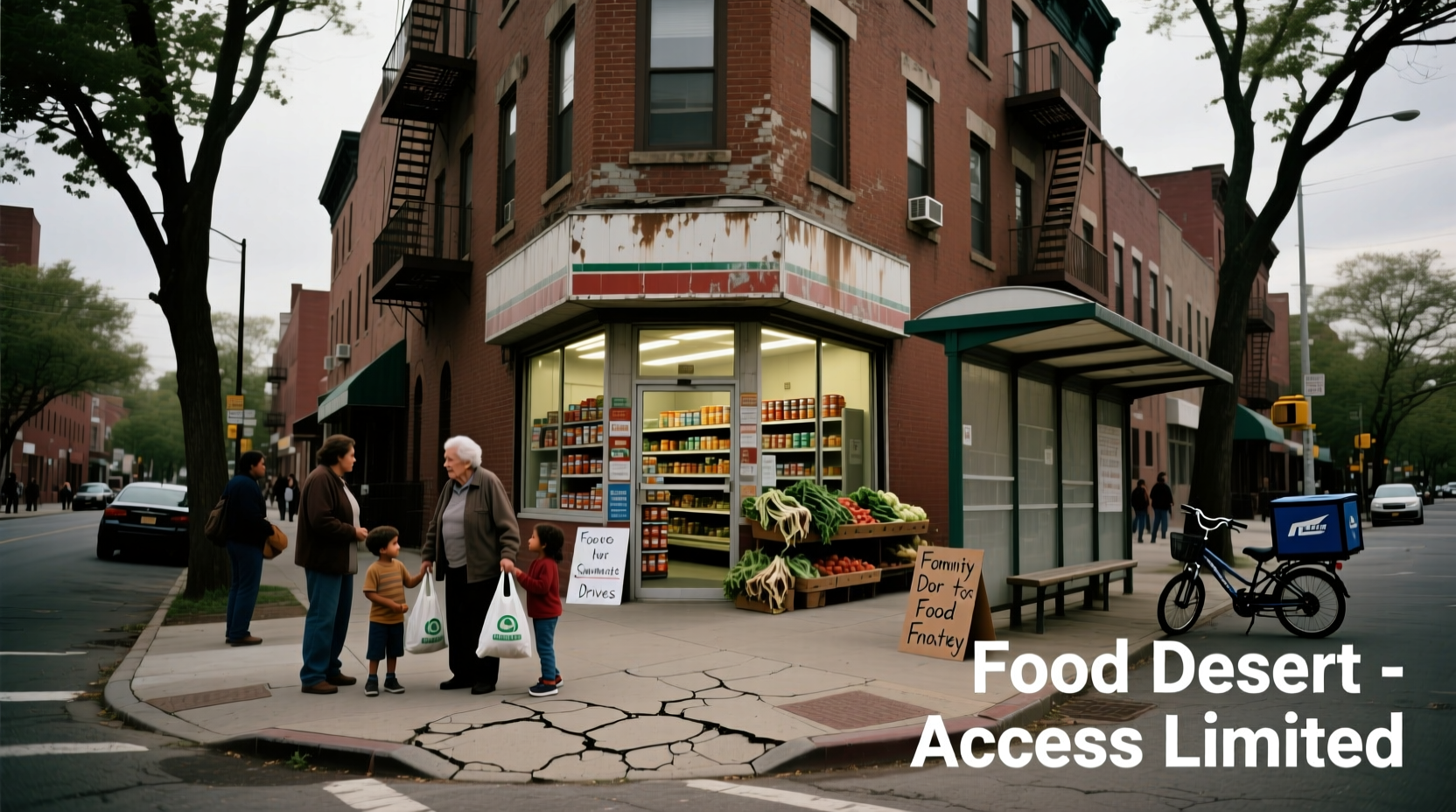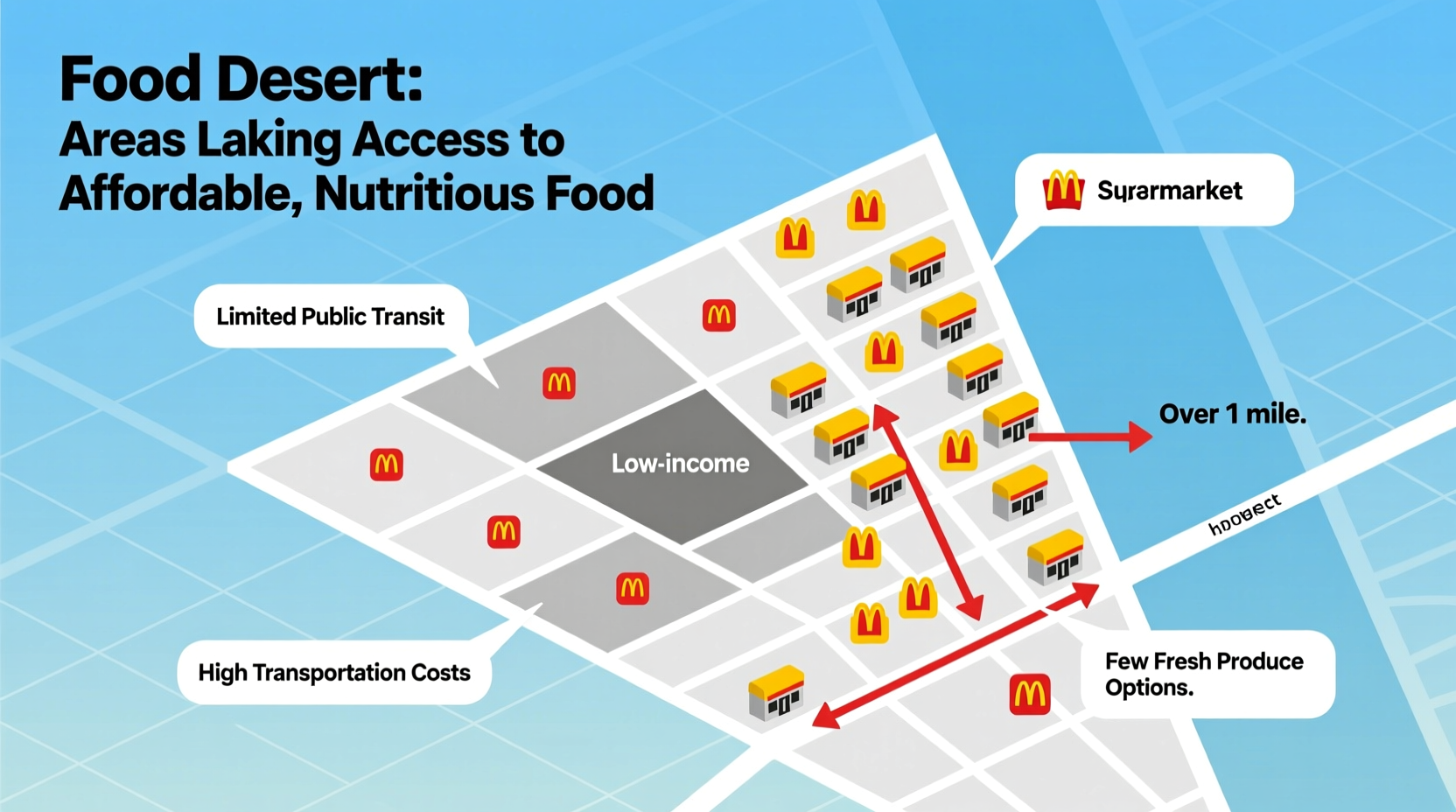Understanding food deserts isn't just academic—it directly impacts millions of Americans' health, economic opportunities, and quality of life. When neighborhoods lack reliable access to fresh produce and healthy food options, residents face higher risks of diet-related diseases and limited culinary choices. This comprehensive guide breaks down the precise criteria that define food deserts, explains why these areas develop, and reveals practical solutions communities are implementing to overcome these challenges.
What Exactly Makes an Area a Food Desert?
The term "food desert" describes geographic areas where residents have limited access to affordable and nutritious food. But the official definition goes beyond simply lacking a grocery store nearby. According to the USDA Economic Research Service, a food desert must meet specific criteria regarding distance, income levels, and vehicle availability.
Key elements in the official food desert definition include:
- Distance threshold: At least 500 people or 33% of the census tract's population live more than 1 mile from a supermarket in urban areas, or 10 miles in rural settings
- Low-income population: Significant portion of residents fall below 200% of the federal poverty line
- Vehicle access: Limited transportation options for residents without personal vehicles
- Store type: Focus on supermarkets and large grocery stores, not convenience stores or gas stations

How Food Deserts Are Officially Measured
The USDA's Food Access Research Atlas provides the most authoritative methodology for identifying food deserts across America. This comprehensive mapping tool evaluates multiple factors simultaneously rather than relying on a single metric.
| Metric | Urban Criteria | Rural Criteria |
|---|---|---|
| Distance to supermarket | 1+ mile | 10+ miles |
| Low-income population | ≥200% of poverty line | ≥200% of poverty line |
| Vehicle access | Limited transportation options | Limited transportation options |
| Population threshold | 500+ people or 33% of tract | 500+ people or 33% of tract |
Evolution of the Food Desert Concept
The understanding of food deserts has evolved significantly since the term first emerged in the 1990s. What began as a simple description of grocery store availability has developed into a sophisticated analytical framework that considers multiple dimensions of food access.
Key milestones in food desert definition development:
- 1990s: Term "food desert" first used in UK policy documents describing urban areas lacking food retail
- 2006: USDA establishes formal criteria through the Food Desert Locator
- 2011: Introduction of the Food Access Research Atlas with improved methodology
- 2016: Updated metrics incorporating vehicle availability and precise geographic analysis
- 2022: Current methodology emphasizes both physical and economic access barriers
Food Deserts vs. Food Swamps: Understanding the Distinction
While food deserts describe areas with limited access to healthy food, food swamps represent a different but related challenge. Understanding this distinction is crucial for developing effective community interventions.
| Characteristic | Food Desert | Food Swamp |
|---|---|---|
| Primary issue | Lack of healthy food retailers | Overabundance of unhealthy food options |
| Store types present | Few or no supermarkets | Many fast food outlets, convenience stores |
| Geographic pattern | Often in low-income urban and rural areas | Can exist in middle-income neighborhoods |
| Solution approach | Attracting grocery stores, mobile markets | Regulating unhealthy food outlets, education |
The Real-World Impact of Food Deserts
Food deserts aren't just theoretical concepts—they have measurable consequences for community health and economic development. Research from the Centers for Disease Control and Prevention shows residents in food deserts face significant health disparities compared to those with better food access.
Documented impacts include:
- 23% higher rates of diet-related diseases like diabetes and heart conditions
- 15% lower consumption of fresh fruits and vegetables among residents
- Increased reliance on processed foods with longer shelf lives
- Higher overall food costs due to limited shopping options
- Reduced economic development as grocery stores often anchor neighborhood commerce
Current Food Desert Statistics Across America
According to the most recent USDA Food Access Research Atlas data from 2023, approximately 19 million Americans live in food deserts. This represents about 6% of the total U.S. population, though the impact is concentrated in specific communities.
Notable statistics include:
- 13.5 million people in urban food deserts
- 5.4 million people in rural food deserts
- 27.3% of food desert residents are children under 18
- Food deserts disproportionately affect communities of color, with 54% of affected residents identifying as non-white
Practical Solutions Communities Are Implementing
Communities aren't powerless against food deserts. Successful interventions address both the physical and economic barriers to healthy food access through creative, locally-tailored approaches.
Effective strategies include:
- Mobile markets: Grocery buses and farmers markets that travel to underserved neighborhoods
- Healthy corner store initiatives: Programs helping small stores stock fresh produce
- Community gardens: Local food production that builds food sovereignty
- Transportation solutions: Grocery shuttle services from transit hubs
- Policy changes: Tax incentives for supermarkets opening in underserved areas
One particularly successful model is the Pennsylvania Fresh Food Financing Initiative, which has helped bring grocery stores to 88 previously underserved communities since 2004, creating over 5,000 jobs while improving food access for 500,000 residents.
How to Determine if Your Area Qualifies as a Food Desert
Curious whether your neighborhood might be considered a food desert? The USDA's Food Access Research Atlas provides an interactive map where you can enter any address to see its food access characteristics. Look for these key indicators:
- Distance to the nearest supermarket (check if it exceeds 1 mile urban/10 miles rural)
- Median household income compared to federal poverty guidelines
- Percentage of households without vehicle access
- Availability of public transportation to grocery stores
Remember that food access exists on a spectrum—just because an area doesn't meet the strict food desert definition doesn't mean residents don't face meaningful barriers to obtaining healthy food.
Common Questions About Food Deserts
What's the difference between a food desert and food insecurity?
Food deserts describe geographic areas with limited physical access to healthy food, while food insecurity refers to the economic inability to afford sufficient nutritious food. A person can experience food insecurity anywhere, but food deserts specifically affect residents of certain neighborhoods regardless of individual income.
Can food deserts exist in wealthy areas?
True food deserts are defined by both geographic isolation from supermarkets AND significant low-income populations. While some wealthy areas might lack grocery stores, they typically don't qualify as official food deserts because residents generally have transportation options and resources to overcome distance barriers.
Do food deserts only affect urban areas?
No, food deserts exist in both urban and rural settings, though the criteria differ. Urban food deserts use a 1-mile threshold to supermarkets, while rural food deserts use a 10-mile threshold due to lower population density and different transportation realities.
How do researchers verify food desert claims?
Researchers use geographic information systems (GIS) to map supermarket locations against census tract data, incorporating income levels, vehicle availability, and precise distance measurements. The USDA's Food Access Research Atlas provides the most comprehensive verification method using multiple data sources including the American Community Survey and commercial business databases.
Are food deserts the same worldwide?
No, while the concept exists globally, the specific definition varies by country. The USDA definition applies specifically to the United States. Other countries use different distance thresholds and criteria based on their population density, transportation infrastructure, and cultural food shopping patterns.











 浙公网安备
33010002000092号
浙公网安备
33010002000092号 浙B2-20120091-4
浙B2-20120091-4